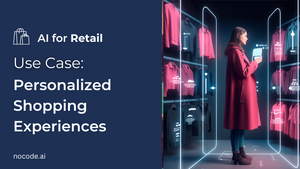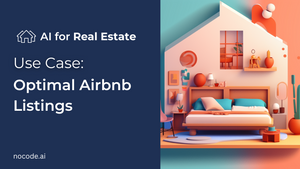In today's digital-driven era, consumers are not just looking for products, they seek personalized experiences that mirror their individual tastes and preferences. As business professionals, one of the key challenges we face in the retail sector is how to deliver this kind of personalized shopping experience consistently and at scale. Fortunately, advances in AI are empowering us to transform this challenge into a unique competitive advantage.
🛍️ The Need for Personalization in Retail
Before delving into how AI makes personalized shopping experiences possible, let's discuss why it matters. The retail landscape is highly competitive, and consumers have a myriad of choices at their fingertips. Standing out in this crowded marketplace requires more than just high-quality products or competitive prices. It's about establishing a meaningful connection with your customers, making them feel understood and valued. This is where personalization comes into play.
A study by Accenture found that 91% of consumers are more likely to shop with brands that recognize, remember, and provide relevant offers and recommendations. But traditional personalization methods, such as manually analyzing customer data or segmenting customers into broad categories, are often insufficient and lack the necessary depth and scalability.
🧠 AI: The Game-Changer for Personalized Retail
AI has emerged as a game-changing technology in the retail sector, offering sophisticated tools to analyze and predict customer behavior with an unprecedented level of accuracy. Here's how it works:
- Analyzing Customer Behavior: AI can process and analyze large volumes of data from various sources, such as transaction histories, browsing patterns, and social media activities. This allows it to develop a deep understanding of each customer's preferences, likes, and dislikes.
- Personalized Recommendations: Based on the insights gained from this analysis, AI can then generate personalized product recommendations that align with the customer's interests. This means customers no longer have to sift through irrelevant products, making their shopping journey more enjoyable and efficient.
- Dynamic Personalization: Perhaps one of the most powerful aspects of AI is its ability to learn and adapt over time. It uses machine learning algorithms to continuously refine its understanding of customer behavior based on new data, enabling it to provide increasingly accurate and relevant recommendations.
⚡️ Key Machine Learning Techniques
There are several algorithms and machine learning techniques that can be utilized for creating a personalized shopping experience.
- Collaborative Filtering: This is a technique used in recommendation systems where recommendations are generated based on the preferences or behaviors of similar users. It leverages the "wisdom of the crowd" to recommend items.
- K-Nearest Neighbors (K-NN): An algorithm used in collaborative filtering, K-NN helps to identify users with similar interests based on their behavioral patterns. These 'neighbors' form the basis for generating personalized recommendations.
- Matrix Factorization (Singular Value Decomposition, SVD): These techniques are particularly useful in dealing with sparse datasets, common in retail where a large number of items have been purchased by a small number of users. They help in reducing the dimensionality of the dataset and in extracting latent factors to make better recommendations.
- Convolutional Neural Networks (CNN): This deep learning method is employed for image-based recommendations. By analyzing product images, CNNs can understand and recommend items that are visually similar to what the customer has shown interest in.
- Reinforcement Learning (Multi-Armed Bandit algorithms): These algorithms adapt recommendations based on user interactions in real-time, balancing between exploration (finding new items to recommend) and exploitation (recommending items that have performed well previously).
- Unsupervised Learning (K-means Clustering): Clustering algorithms like K-means can segment customers into distinct groups based on their behavior or other characteristics. This segmentation allows for targeted recommendations that cater to the specific preferences of each group.
🤖 A Python Example for a Recommender System
Let's use a simple example of a recommendation system using collaborative filtering with the K-Nearest Neighbors algorithm. We will use the surprise library, which is a Python scikit for building and analyzing recommender systems.
from surprise import KNNWithMeans, Dataset, accuracy
from surprise.model_selection import train_test_split
# Load the movielens-100k dataset.
data = Dataset.load_builtin('ml-100k')
# Split the dataset into train and test.
trainset, testset = train_test_split(data, test_size=0.2)
# Use user-based collaborative filtering, cosine similarity measure.
algo = KNNWithMeans(sim_options={'name': 'cosine', 'user_based': True})
# Train the algorithm on the trainset.
algo.fit(trainset)
# Predict ratings for all pairs (u, i) that are NOT in the training set.
predictions = algo.test(testset)
# Compute and print Root Mean Squared Error.
print(accuracy.rmse(predictions))
In this example, the KNNWithMeans class is used to implement the K-Nearest Neighbors algorithm with means. The algorithm is trained on a training set, and then the predictions are made on the test set. Finally, the accuracy of the predictions is computed and printed.
Please note that this is a simplistic example that uses the Movielens-100k movie ratings dataset. For a real-world retail application, you would likely need a more complex setup, including data preprocessing steps and more sophisticated algorithms, and you would need to work with your own product and customer data.
Remember to install the surprise library before running the code. You can do it by running pip install scikit-surprise in your command line.
🤩 The Benefits of AI-Driven Personalized Shopping Experiences
Investing in AI-driven personalization can yield significant benefits for retailers:
- Increased Sales: By presenting customers with products that match their preferences, you're more likely to convert browsers into buyers, thereby boosting your sales.
- Customer Loyalty: Customers who feel understood and valued are more likely to stick with your brand. By consistently providing personalized experiences, you can foster loyalty and drive repeat purchases.
- Improved Customer Satisfaction: Personalization can transform the shopping experience from a chore into a pleasure, leading to higher levels of customer satisfaction.
🚀 The Impact
The implementation of AI is revolutionizing the retail industry. It's not only boosting customer engagement and revenue for the businesses that adopt it but is also reshaping customer expectations and standards for shopping experiences.
Business Impact: Businesses adopting AI have seen increases in key metrics:
- 20% increase in customer engagement
- 10-15% increase in conversion rates
- 6-10% growth in revenue
Economic Impact:
- The global economy could see a $15.7 trillion boost by 2030 due to AI, with retail being a key sector.
- New job categories and upskilling opportunities are being created within the retail sector, aiding economic development.
In conclusion, as we navigate the future of retail, it's clear that AI-driven personalization is not just a nice-to-have but an essential strategy for business professionals. The time to embrace this transformative technology is now. Not only will it help you meet your customers' rising expectations for personalized experiences, but it will also set your business up for sustained success in an increasingly competitive landscape.




